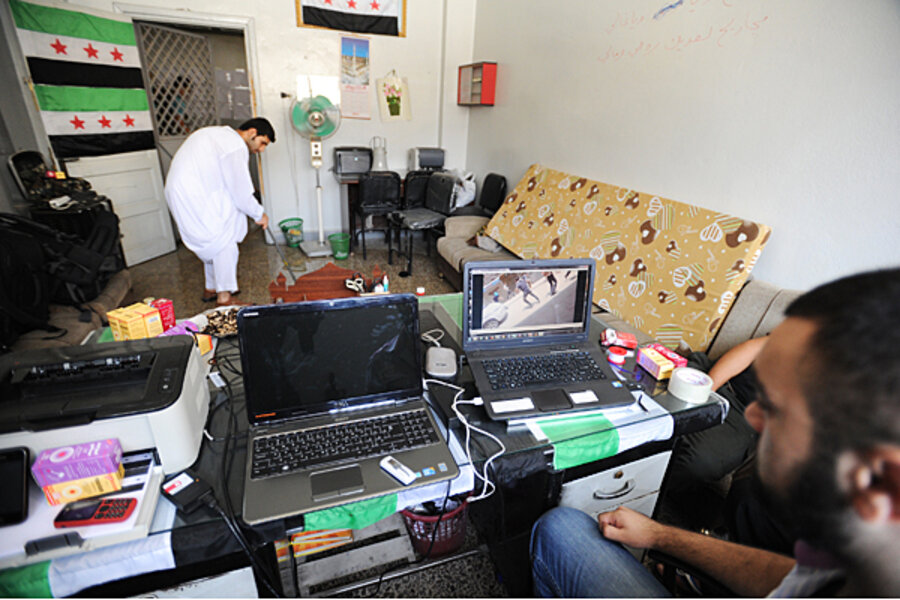Syria's iPhone insurgency makes for smarter rebellion
Loading...
| Aleppo, Syria
News from the Aleppo frontline sounded good: Syrian rebels had expected the enclave under their control might be overrun by superior government forces, but instead they stopped the advance and knocked out several armored vehicles, leaving dead Syrian troops on the road.
But were those reports real?
The answer came within an hour, a couple blocks from that fight in the embattled Salaheddin district, when a rebel in civilian clothes appeared with a beaming smile and a small video camera.
His footage clearly showed a smoldering hole in a Syrian armored personnel carrier, and several uniformed soldiers lying dead in the road, where they had taken up firing positions.
"He's a hero!" sang one rebel fighter about the cameraman, who faced sniper fire from Syrian forces to get the shots.
Like so much of the combat footage of this 17-month uprising against the rule of President Bashar al-Assad, this was taken by a rebel activist to be loaded onto YouTube.
Forget the image of anti-regime guerrillas holed up in some remote trench, cut off from the world as they battle government forces. This fight has been defined in Syria by endless images shot by mobile phone and volunteer videographers who know the importance of winning the media war.
Every fighter seems to have at least one mobile phone, used to speak with families, Skype girlfriends, and even advise Syrian soldiers how to defect to the opposition. Some note the difference a generation can make to the fate of their challenge against the government – and providing video evidence of atrocities and war crimes that are corroding the legitimacy of the regime.
Lounging after a dinner to break the day's Ramadan fast as incoming artillery fire strikes nearby buildings, they recall how the current president's father, Hafez al-Assad, who ruled Syria from 1970, ordered the destruction of the city of Hama in 1982, killing at least 10,000 to crush a Muslim Brotherhood uprising.
"His father destroyed Hama in a few days, but there was no TV there and no Internet to show the world," one rebel fighter told the Monitor. "But today we have the Internet, we photograph and film and have Al Jazeera, so people know. They can see what is happening."
Wielding thumb drives as a weapon
Making that happen has been no accident. Arriving at one makeshift rebel headquarters in a Salaheddin building with thick walls, rebel media activist Abu Mhio sits at a desk-turned-command center.
Two laptop computers sit with lids up, importing and showing combat video. Scattered about are external hard drives, video and still cameras, mobile phones, and a tangle of cables – the tools of war and public persuasion that have become prominent in Syria like no other Arab Spring revolt.
Abu Mhio's first question to a visiting journalist is: "Do you have a thumb drive?"
As he downloads images and video onto the drive, Abu Mhio explains his homegrown effort – one that has been repeated by activists across the country since the uprising began in March 2011, with anti-regime street protests that evolved into armed opposition and now civil war.
"Everything here is from my house," says Abu Mhio. "This is my laptop. This is my camera. This is a printer from my friend. We have no help from outside."
While there may be little help, there is a lot of impact from such simple tools.
Abu Mhio scrolls through still images, as some rebel fighters gather round to look. There is a dumpster overflowing with garbage and plastered with posters of the president. "House of Assad," Abu Mhio says, as the gunmen laugh.
But then there is an image of a 10-year-old boy, killed just two days before by a government artillery shell that tore apart his leg. In another frame a man lies dead on a sidewalk, face down in a pool of blood, apparently shot by a pro-regime militiaman, says Abu Mhio.
As the slideshow continues, a medic brings in a small piece of shrapnel – flat, sharp and shaped like a fish hook – that was just extracted from someone in the next room.
Abu Mhio takes a look, then plucks from the desk next to his computer another piece of shrapnel the size of a marble, which was extracted from someone else. It is a reality given digital life on the screens.
There are videos of past protests, including one from June 22 in which Syrian security forces opened fire, killing several demonstrators. Another protest at night resembles the crowd at a soccer match, chanting loudly in unison and lighting flares.
At one demonstration, a leaflet is held up to the camera that reads: "Warning: The Syrian [state] TV is the main cause of dissemination of discord between Syrians."
Anti-regime media activists are trying to change that. Several rebels nod when Abu Mhio says, "When we will be free, [Syrian TV] will be dead."
And their screen saver of choice? You can also find it on mobile phones across this rebel enclave. Inspired by the world of video games, it is black, with white words in capital letters they hope apply to the rule of Assad: "GAME OVER."
Scott Peterson left the Salaheddin district of Aleppo late on the afternoon of July 29 after three days in the enclave, when this story was reported. Follow him on Twitter.





